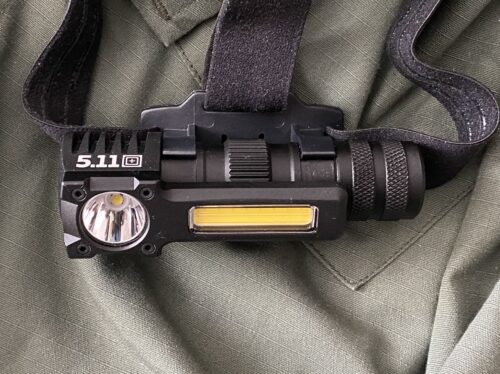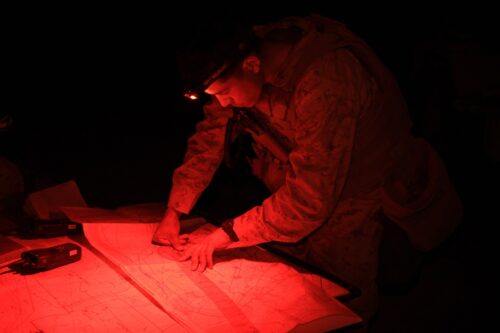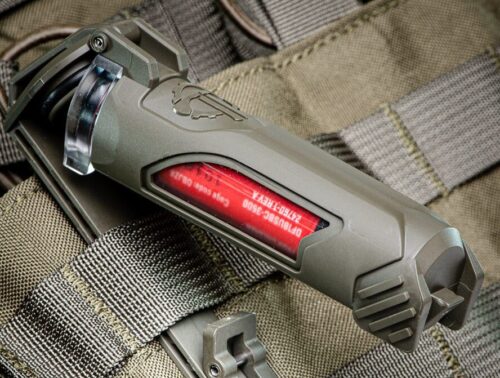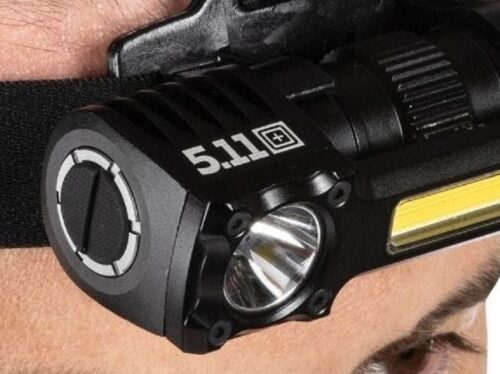Members of Navy Explosive Ordnance Disposal Mobile Unit (EODMU) conducting a Final Evaluation Phase of training to simulate operations the team may experience while supporting maritime security operations (MSO). Headlamps provide a hands-free source of direct light that can be advantageous in many situations. US Navy photo by Photographer’s Mate 1st Class Aaron Ansarov (RELEASED)
A headlamp is an essential tool that should be part of everyone’s kit. Having a hands-free light source is vital in many situations. However, choosing the right headlamp can be a daunting task given the wide variety of options available on the market. Here are some considerations that you should take into account when purchasing a headlamp:
1. Beam Type
The beam type of a headlamp determines its versatility. There are three main types:
Flood (or Wide): Useful for general use and up-close tasks. Flood beams do not throw light a long distance.
Spot (or Focused or Narrow): Best for long-distance viewing. It is also usually the better choice for navigating in the dark.
Flood/Spot: Adjustable headlamps that offer both flood and spot beams offer the greatest versatility.

2. Light Output (Lumens)
Lumens are a unit of measure that gauges the total quantity of light emitted in all directions by a light source. A light with a high lumens count will typically consume energy at a higher rate than a light with a lower lumens number. How well a headlamp maker focuses and directs that light can impact how those lumens are utilized.
3. Beam Distance
A headlamp’s fundamental purpose is to channel light to a target area. Headlamps are tested to determine how far (in meters) they can project usable light. While lumens tell you how bright a headlamp is (at its source), headlamp beam distance tells you how far it goes (to a surface you want illuminated).
4. Run Time
This spec gives you a sense of how long your headlamp will last from the time it is fully charged. The current standard uses 10 percent of a light’s original brightness as the point where run time ends.

5. Weight and Comfort
Most headlamps, with batteries included, weigh less than 7 ounces and are of similar size. You won’t notice substantial differences in headlamp size and weight until you start examining some very high-powered models. The design of the headband is also important for comfort.
6. Water Resistance
Most headlamps are rated IPX4 or better. The IPX4 rating indicates that the headlamp is resistant to splashes of water from any direction, sufficient to operate in sustained rainstorms.
Some headlamps even have a higher rating, such as 1PX7 or IPX8, which means they can be submerged in water. The specific rating can vary depending on the model and manufacturer. Always check the product specifications to ensure it meets your needs.

7. Light Modes
Headlamps come with different light modes to meet a variety of needs. Below are some typical modes and terms you may find:
Full-Beam (or High-Beam): Maximum light output mode, providing the brightest light for clear visibility in dark environments.
Low-Beam: Offers a dimmer light, which is useful for close-up tasks or to conserve battery life.
Medium-Beam: Offered on some models to give users an additional option.
Fully Adjustable Beam: A few models offer fully adjustable output.
Proximity or Flood Mode: Provides a wide, less intense beam of light that is ideal for tasks within a close range, such as reading or cooking at a campsite.
Distance or Spot Mode: In contrast to proximity mode, distance mode provides a narrow, intense beam of light that illuminates objects far away, making it useful for navigating trails at night.
Strobe Mode: Emits a flashing light, which can be used for signaling in emergency situations or to draw attention.
Red Mode: Red light is the best color for preserving night vision because it is only picked up by the cones, leaving the rods, which are used to see in the dark, unaffected. It is less visible from a distance and illuminates without causing a stark contrast. Since 1982, all US military top maps are red-light readable. Red light can interfere with patient assessment, especially when it comes to assessing skin color and blood perfusion. It is recommended to use white light when assessing patients.
Green Mode: Green light falls just behind red when it comes to preserving night vision, but it is better for improving clarity and contrast. Your eyes will adjust faster with green than with a white light, but go with red if you don’t need to pick out finite details in the dark.
Blue Mode: Blue light can impair night vision and, contrary to popular belief, won’t help you track a blood trail when you’re hunting. It should be noted that night vision can be ruined by bright light of any color. It is best to use the least amount of light possible.
IR Mode: Allows for illumination that is not visible to the naked eye but can be picked up by night vision devices.

8. Battery Type
The type of battery used in a headlamp is a crucial factor to consider when making your selection. This is because the battery type can significantly impact the performance, cost-effectiveness, and environmental footprint of your headlamp. The choice of battery type in a headlamp should align with your specific usage requirements and frequency of use. A standardized battery type across platforms can be a convenience and logistical consideration.
Headlamps powered by rechargeable batteries, also referred to as secondary batteries, are often favored for their long-term cost-effectiveness. Despite a higher upfront cost, these headlamps can save you money over time as you won’t need to constantly purchase batteries. They also contribute less to waste, making them a more environmentally friendly choice.
Headlamps that use single-use (non-rechargeable) batteries, also referred to as primary batteries, can be convenient for occasional use or as a backup option. Single-use batteries are widely available and easy to replace, making them a practical choice for situations where recharging may not be possible.
Some headlamps even offer the flexibility of using both rechargeable and non-rechargeable batteries These hybrid models provide the best of both worlds, allowing you to switch between power sources based on your needs.
The size of the battery is also a consideration in relation to your specific needs, including the desired performance, weight, and convenience.
Headlamps with replaceable batteries allow you to quickly get the light going when the batteries run down. The Thyrm® CellVault® battery storage system is a great way to carry and protect spares.

9. Operation
The process of operating your headlamp should be straightforward and intuitive. The design should allow for easy access to the on/off switch and mode selector, even in dark or cold conditions. Ideally, switching between different light modes should be a simple task, not requiring complex sequences of button presses, allowing you to quickly adapt to changing environments and tasks.
10. Mounting Bracket: Some headlamps feature a mounting bracket that allows the light to be rotated as needed.

Summary
When choosing a headlamp, consider factors like brightness (lumens), beam type, battery type, size and runtime, weight and comfort, water resistance, durability, light modes, operation, additional features, price, brand, and warranty. The right headlamp for you depends on your specific needs and usage.
Sources
5.11
511Tactical.com
Thyrm
Thyrn.com
*The views and opinions expressed on this website are solely those of the original authors and contributors. These views and opinions do not necessarily represent those of Spotter Up Magazine, the administrative staff, and/or any/all contributors to this site.
